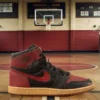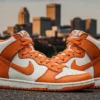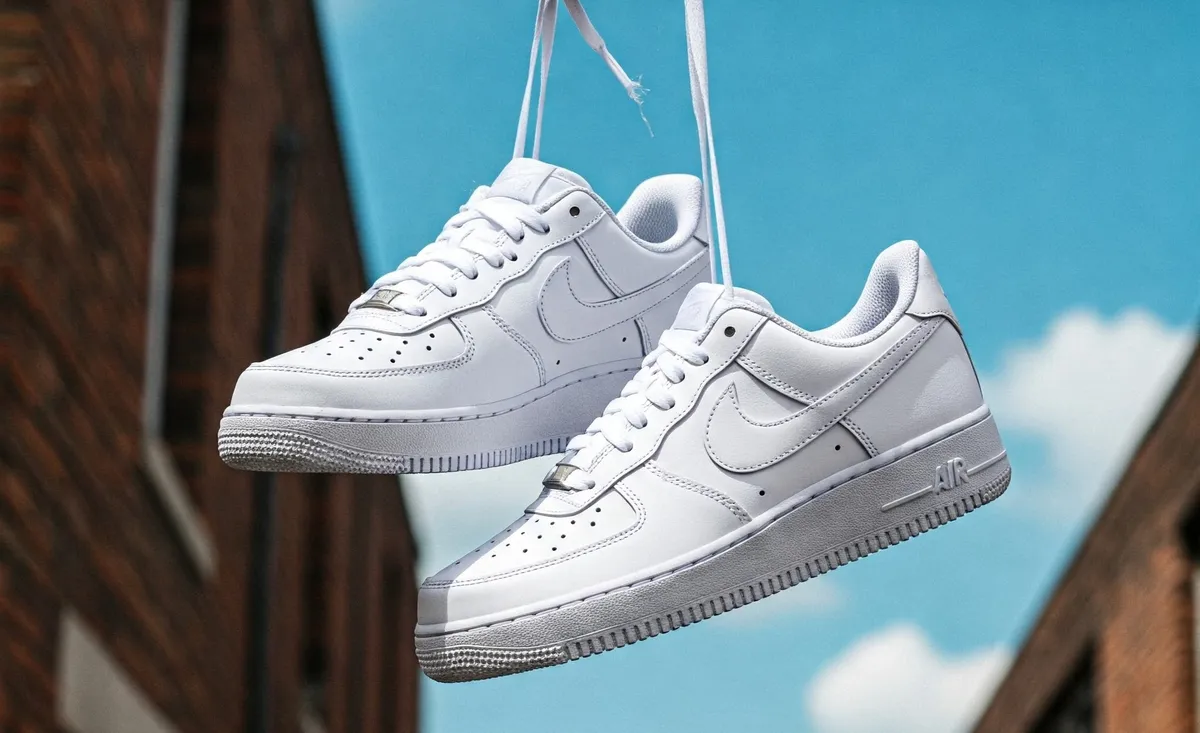Picture a sneaker born to solve a problem on the basketball court but ended up taking over the streets, hip-hop, and even celebrity wardrobes. That’s the Nike Air Force One, a shoe that’s been bridging generations and styles for over 40 years. Launched in 1982, it’s not just one of Nike’s best-selling sneakers ever—it’s a legit pop culture legend. Want to know how this icon went from sports to a symbol of authenticity and versatility? Grab a coffee, kick back, and join me on this trip down memory lane!
In this article, we’ll dive into the Air Force One’s origins, its ups and downs, and how it became a global must-have. We’ll cover its game-changing design, historic collabs, and even the moments it nearly vanished, only to come back stronger. Whether you’re a sneakerhead or just curious about how a simple shoe can make history, this one’s for you.
The Origin: A Sneaker Built for the Game
It all started in 1982 when Nike decided it was time to shake up the basketball market. The brand had already made waves with its Air technology in running shoes like the 1978 Nike Air Tailwind. But basketball? That was a new frontier. Enter Bruce Kilgore, a designer tasked with creating something to protect NBA players’ feet. Back then, players were dealing with brutal impacts, often stuffing their shoes with extra socks to cushion their jumps.
The result was the Nike Air Force One, named after the U.S. president’s plane, hinting at its larger-than-life vibe. It came with a chunky midsole and Air technology—air-filled chambers to absorb impact. The design was clean but practical: premium leather, high-top ankle support, and a circular sole pattern for quick moves. It was perfect for the court, but no one could’ve predicted it would go way beyond that.
The Launch and First Steps
The Air Force One didn’t blow up overnight. When it debuted, Nike knew it had to sell this beefy sneaker to both players and fans. Their plan? Recruit the “Original Six,” a crew of NBA stars like Moses Malone and Michael Cooper. They were photographed in an iconic campaign, posing in a hangar like they were pilots of the “Air Force One.” The message was clear: this shoe would take your game to new heights.
It worked. Players started rocking the shoe, and fans caught on that something special was happening. The Air cushioning was a game-changer, but the clean look with a subtle Swoosh on the sides turned heads too. In 1983, Nike dropped a low-top version, opening the door to a wider audience. But it wasn’t all smooth sailing: in 1984, Nike decided to discontinue the Air Force One to focus on new projects. It seemed like the end—until the fans stepped in.
The Baltimore Revival: The Power of Fans
If the Air Force One is what it is today, you can thank Baltimore. When Nike announced it was pulling the plug, three local stores—Charley Rudo Sports, Cinderella Shoes, and Downtown Locker Room—refused to let the sneaker die. They convinced Nike to keep supplying exclusive pairs for the city, launching the “Color of the Month Club.” Each month brought a new colorway, and East Coast sneakerheads made pilgrimages to cop their pairs.
This movement didn’t just save the Air Force One—it laid the foundation for today’s collector culture. Nike realized its mistake and, in 1986, brought the shoe back globally with a modernized logo. That’s when it started taking over the streets, especially in New York, where Harlem dubbed it “Uptowns,” a sign it was leaving the courts behind.
From Sports to Hip-Hop: The Cultural Shift
If the ‘80s were about basketball, the ‘90s were about style. The Air Force One found a new home in hip-hop culture, especially with the release of the “white on white,” the classic all-white version that became a craze. Artists like Jay Z, Nelly, and Fat Joe didn’t just wear the sneaker—they made it a status symbol. In 2002, Nelly dropped the song “Air Force Ones,” which blew up on the charts and put the sneaker on everyone’s radar.
Hip-hop embraced the Air Force One for its simplicity and versatility. It went with everything, from baggy jeans to oversized tees, and screamed authenticity. In Harlem, keeping your “Uptowns” crispy white was practically a badge of honor. This connection to music and urban fashion was key to cementing the sneaker’s status as a cultural icon, something even Nike couldn’t have seen coming.
The Design Evolution: Tradition Meets Innovation
The Air Force One never stopped evolving. From the original high-top, it spawned mid-top, low-top, and even special editions with details like velcro straps or platform soles. The Air technology stayed at the core, but premium leather and customization options like NikeiD, launched in the 2000s, kept it fresh.
A big moment came in 2017 for the Air Force One’s 35th anniversary. Nike tapped names like Virgil Abloh and Travis Scott for limited-edition collabs, like the AF 100 collection. These designs didn’t just celebrate the sneaker’s legacy—they took its hype to a whole new level. More recently, partnerships with brands like Louis Vuitton and Tiffany & Co. proved the Air Force One can be both streetwear and high fashion.
The Global Impact: A Sneaker Without Borders
Today, the Air Force One is a worldwide phenomenon. It’s been released in over 1,700 colorways and has raked in billions for Nike. From Japan, where exclusives like the 2001 “Linen” became legendary, to the U.S., where it still rules streetwear, this sneaker has crossed cultures and continents. Celebs like Rihanna, Kendrick Lamar, and even Hailey Bieber are spotted rocking their pairs, proving its universal appeal.
So what’s behind its success? Part of it’s nostalgia—anyone who grew up in the ‘90s or 2000s feels a connection to this shoe. Part of it’s the timeless design that works just as well for skating as it does for a casual dinner. And, of course, Nike’s kept it relevant with strategic drops and sharp marketing. According to Nike, the Air Force One is still their top-selling shoe of all time.
Fun Facts You Need to Know
Did you know the Air Force One almost became a hiking boot? Bruce Kilgore drew inspiration from hiking boots for the original design, which explains the sturdy ankle support. Another tidbit: for its 25th anniversary in 2007, Nike dropped luxury editions made in Italy with crocodile leather and gold details, costing up to $2,000. Little details like these show how this sneaker’s always been a step ahead.
Here’s more: the “Uptowns” nickname isn’t official, but it caught on so much that even Nike’s used it in campaigns. And that medallion on the laces? It’s removable, but a lot of people don’t even realize it. These small stories make the Air Force One even more fascinating.
Conclusion: Why the Air Force One Still Wins Us Over
Looking back, it’s clear the Nike Air Force One is more than just a sneaker—it’s a piece of history. It started as a practical solution for athletes but became a symbol of identity, creativity, and resilience. For those of us who’ve followed its journey, it’s a reminder of how culture can turn simple objects into timeless icons. Whether it’s the design, the nostalgia, or the cultural impact, the Air Force One keeps holding strong, proving a true classic never goes out of style.
FAQ: Common Questions About the Nike Air Force One
When Was the Nike Air Force One Released?
The Nike Air Force One dropped in 1982 as a basketball shoe designed by Bruce Kilgore.
Why’s It Called Air Force One?
The name’s a nod to the U.S. president’s plane, suggesting strength and prestige.
What’s the Air Technology in the Air Force One?
It’s a cushioning system with air-filled chambers in the midsole, built to absorb impact.
What Was the First Color of the Air Force One?
The original was white with neutral gray details, a clean and functional look.
Who Saved the Air Force One From Disappearing?
Baltimore shops like Charley Rudo Sports pushed Nike to keep production going in 1984.
What’s the Most Popular Air Force One Version?
The “white on white” low-top is considered the most iconic and best-selling.
What Are the Most Famous Collabs?
Standouts include partnerships with Virgil Abloh, Travis Scott, Louis Vuitton, and Tiffany & Co.
Why’s It Called “Uptowns”?
The nickname came from Harlem, New York, where the sneaker became a streetwear staple.
How Many Colors Has the Air Force One Had?
Over 1,700 color variations have been released since 1982.
Is the Air Force One Still Relevant Today?
Absolutely—it’s still one of Nike’s top-selling sneakers and a global streetwear icon.
 Nike x Off-White: The Collaboration That Revolutionized Sneakers and Fashion
Nike x Off-White: The Collaboration That Revolutionized Sneakers and Fashion Air Jordan 1 – The Story of the Sneaker that Defied the Rules and Became Legend
Air Jordan 1 – The Story of the Sneaker that Defied the Rules and Became Legend What is Nike Air? Learn more about one of Nike’s Best Technologies
What is Nike Air? Learn more about one of Nike’s Best Technologies Top 10 Futuristic Nike Sneakers: Innovative Design and Cutting-Edge Technology
Top 10 Futuristic Nike Sneakers: Innovative Design and Cutting-Edge Technology The Journey of the Nike Dunk: A Timeless Story of Courts, Streets, and Culture
The Journey of the Nike Dunk: A Timeless Story of Courts, Streets, and Culture